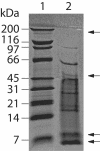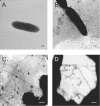The type III-dependent Hrp pilus is required for productive interaction of Xanthomonas campestris pv. vesicatoria with pepper host plants
- PMID: 15774889
- PMCID: PMC1065247
- DOI: 10.1128/JB.187.7.2458-2468.2005
The type III-dependent Hrp pilus is required for productive interaction of Xanthomonas campestris pv. vesicatoria with pepper host plants
Abstract
The plant pathogenic bacterium Xanthomonas campestris pv. vesicatoria expresses a type III secretion system that is necessary for both pathogenicity in susceptible hosts and the induction of the hypersensitive response in resistant plants. This specialized protein transport system is encoded by a 23-kb hrp (hypersensitive response and pathogenicity) gene cluster. Here we show that X. campestris pv. vesicatoria produces filamentous structures, the Hrp pili, at the cell surface under hrp-inducing conditions. Analysis of purified Hrp pili and immunoelectron microscopy revealed that the major component of the Hrp pilus is the HrpE protein which is encoded in the hrp gene cluster. Sequence homologues of hrpE are only found in other xanthomonads. However, hrpE is syntenic to the hrpY gene from another plant pathogen, Ralstonia solanacearum. Bioinformatic analyses suggest that all major Hrp pilus subunits from gram-negative plant pathogens may share the same structural organization, i.e., a predominant alpha-helical structure. Analysis of nonpolar mutants in hrpE demonstrated that the Hrp pilus is essential for the productive interaction of X. campestris pv. vesicatoria with pepper host plants. Furthermore, a functional Hrp pilus is required for type III-dependent protein secretion. Immunoelectron microscopy revealed that type III-secreted proteins, such as HrpF and AvrBs3, are in close contact with the Hrp pilus during and/or after their secretion. By systematic analysis of nonpolar hrp/hrc (hrp conserved) and hpa (hrp associated) mutants, we found that Hpa proteins as well as the translocon protein HrpF are dispensable for pilus assembly, while all other Hrp and Hrc proteins are required. Hence, there are no other conserved Hrp or Hrc proteins that act downstream of HrpE during type III-dependent protein translocation.
Figures









Similar articles
-
Domain structure of HrpE, the Hrp pilus subunit of Xanthomonas campestris pv. vesicatoria.J Bacteriol. 2005 Sep;187(17):6175-86. doi: 10.1128/JB.187.17.6175-6186.2005. J Bacteriol. 2005. PMID: 16109959 Free PMC article.
-
hrpf of Xanthomonas campestris pv. vesicatoria encodes an 87-kDa protein with homology to NoIX of Rhizobium fredii.Mol Plant Microbe Interact. 1997 May;10(4):488-98. doi: 10.1094/MPMI.1997.10.4.488. Mol Plant Microbe Interact. 1997. PMID: 9150597
-
Identification of six type III effector genes with the PIP box in Xanthomonas campestris pv. campestris and five of them contribute individually to full pathogenicity.Mol Plant Microbe Interact. 2009 Nov;22(11):1401-11. doi: 10.1094/MPMI-22-11-1401. Mol Plant Microbe Interact. 2009. PMID: 19810809
-
Type III effector proteins from the plant pathogen Xanthomonas and their role in the interaction with the host plant.J Plant Physiol. 2006 Feb;163(3):233-55. doi: 10.1016/j.jplph.2005.11.011. Epub 2005 Dec 28. J Plant Physiol. 2006. PMID: 16386329 Review.
-
Getting across--bacterial type III effector proteins on their way to the plant cell.EMBO J. 2002 Oct 15;21(20):5313-22. doi: 10.1093/emboj/cdf536. EMBO J. 2002. PMID: 12374732 Free PMC article. Review.
Cited by
-
Functional characterization of the type III secretion ATPase HrcN from the plant pathogen Xanthomonas campestris pv. vesicatoria.J Bacteriol. 2009 Mar;191(5):1414-28. doi: 10.1128/JB.01446-08. Epub 2008 Dec 29. J Bacteriol. 2009. PMID: 19114489 Free PMC article.
-
Innate immunity signaling: cytosolic Ca2+ elevation is linked to downstream nitric oxide generation through the action of calmodulin or a calmodulin-like protein.Plant Physiol. 2008 Oct;148(2):818-28. doi: 10.1104/pp.108.125104. Epub 2008 Aug 8. Plant Physiol. 2008. PMID: 18689446 Free PMC article.
-
The type III protein secretion system contributes to Xanthomonas citri subsp. citri biofilm formation.BMC Microbiol. 2014 Apr 18;14:96. doi: 10.1186/1471-2180-14-96. BMC Microbiol. 2014. PMID: 24742141 Free PMC article.
-
Comparative genomics of host adaptive traits in Xanthomonas translucens pv. graminis.BMC Genomics. 2017 Jan 5;18(1):35. doi: 10.1186/s12864-016-3422-7. BMC Genomics. 2017. PMID: 28056815 Free PMC article.
-
The Predicted Lytic Transglycosylase HpaH from Xanthomonas campestris pv. vesicatoria Associates with the Type III Secretion System and Promotes Effector Protein Translocation.Infect Immun. 2017 Jan 26;85(2):e00788-16. doi: 10.1128/IAI.00788-16. Print 2017 Feb. Infect Immun. 2017. PMID: 27895129 Free PMC article.
References
-
- Aiba, H., S. Adhya, and B. de Crombrugghe. 1981. Evidence for two functional gal promoters in intact Escherichia coli cells. J. Biol. Chem. 256:11905-11910. - PubMed
-
- Ausubel, F. M., R. Brent, R. E. Kingston, D. D. Moore, J. G. Seidman, J. A. Smith, and K. Struhl. 1996. Current protocols in molecular biology. John Wiley & Sons, New York, N.Y.
-
- Bogdanove, A. J., S. V. Beer, U. Bonas, C. A. Boucher, A. Collmer, D. L. Coplin, G. R. Cornelis, H. C. Huang, S. W. Hutcheson, N. J. Panopoulos, and F. Van Gijsegem. 1996. Unified nomenclature for broadly conserved hrp genes of phytopathogenic bacteria. Mol. Microbiol. 20:681-683. - PubMed
-
- Bonas, U., R. Schulte, S. Fenselau, G. V. Minsavage, B. J. Staskawicz, and R. E. Stall. 1991. Isolation of a gene cluster from Xanthomonas campestris pv. vesicatoria that determines pathogenicity and the hypersensitive response on pepper and tomato. Mol. Plant-Microbe Interact. 4:81-88.
Publication types
MeSH terms
Substances
LinkOut - more resources
Full Text Sources
Other Literature Sources
Molecular Biology Databases

